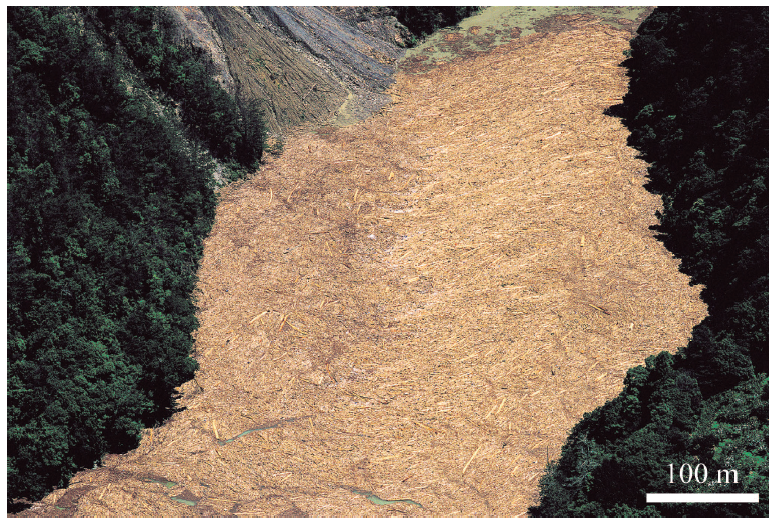This paper, led by Josh West and colleagues in Taiwan, was published in Limnology and Oceanography. The full text is available via the journal website, since all L&O papers become open access after three years.
The island of Taiwan, in the South China Sea, has an interesting, yet devastating, combination of climate, biology and geology. It sits on the plate boundary between Eurasia and the Phillipines, which are moving into each other and causing the island to rise out of the ocean. This leads to earthquakes as the land is pushed up, and rapid erosion as the mountains get steeper and taller. The mountain sides collapse as landslides, producing sediment that is prone to being washed away by Taiwan’s many rivers. These rivers may not be the longest in the world, but they carry a lot of water, because Taiwan sits in the tropical zone where the year-round high levels of rainfall are topped up by several typhoons each year. The final piece of this jigsaw is the biology – being in a warm, wet region means that Taiwan is very biologically productive, with extremely fast forest growth rates.

Coupling all of these features together leads to a heavily forested mountainous island on which the hillsides are regularly landsliding and generating woody debris (tree trunks, branches, shrubs etc.) The large typhoons that hit the island each year provide water which washes the woody debris into the rivers and then out to the ocean.
In 2009, Taiwan was struck by a particularly devastating tropical cyclone, Typhoon Morakot. The island received about 4 metres of rainfall in just a couple of days, enough to cause rivers to burst their banks, washing away entire villages and unfortunately leading to several deaths. I visited the island a few months later, and the clear-up operation was still going on. Beside the rivers was up to a metre of chaotic sediment with tree branches sticking out of it, since the waters had carried everything off the hillside and dumped it when the floods receded. A lot of the tree trunks made it all the way through the river, out to the sea. They washed up on the shoreline around Taiwan, and were reported as far away as Japan.

These trees contain a lot of carbon, which has been moved from the hillside to the floodplain and out to the sea. Our study tried to work out just how much carbon, in the form of coarse woody debris, was being transported during this storm. Single river channels, such as the picture above, could contain 40 million tonnes of carbon – how much carbon was washed away by the whole storm?
There were two independent methods used to make the carbon estimates. The first one compared aerial photography before and after the storm to look at how much area was affected by landslides, and how much of the island was covered in forest. If you combine the forest cover data with the landslide map, and correct for areas where landslides do not deliver the woody debris to the river network, an estimate of carbon mobilisation can be made
The second method used reservoirs as sampling facilities. Reservoirs have filters to stop large trees going through their exit pipelines, and so any woody debris reaching the reservoir will be stopped at the dam (see the top picture for an extreme example). Knowing the area of land that drains into the reservoir, and the amount of wood trapped at the dam, you can scale up to the area of the entire river catchment.
Both of these methods produced similar results, they agreed that there was a shocking amount of carbon washed to the ocean during the storm. The storm delivered 3.8 – 8.4 Teragrams of woody debris from Taiwan to the ocean, which represents 1.8 – 4.0 Teragrams of carbon. This is about 1/4 the annual delivery of carbon from the Amazon River, but most of that is as small particles. The woody debris delivery in these few days was over 10 times greater than the annual woody debris delivery from the Amazon. So one single event on a small island was significant from a global point of view, but how much carbon is a Teragram?
One Teragram is equal to one million tonnes; an oil tanker can carry 300 000 tonnes of oil (mostly carbon) and therefore the storm delivered 10 oil tankers worth of carbon to the ocean. Obviously this event is not as disastrous as an oil tanker spill – the woody material will rot down and provide food for ocean-living creatures as well as potentially being buried safely in the sediments.
Our paper shows just how much carbon can be washed away by a single storm, and highlights that large pieces of woody debris, too large to analyse by most techniques, are an important and probably under-studied element of the organic carbon cycle.